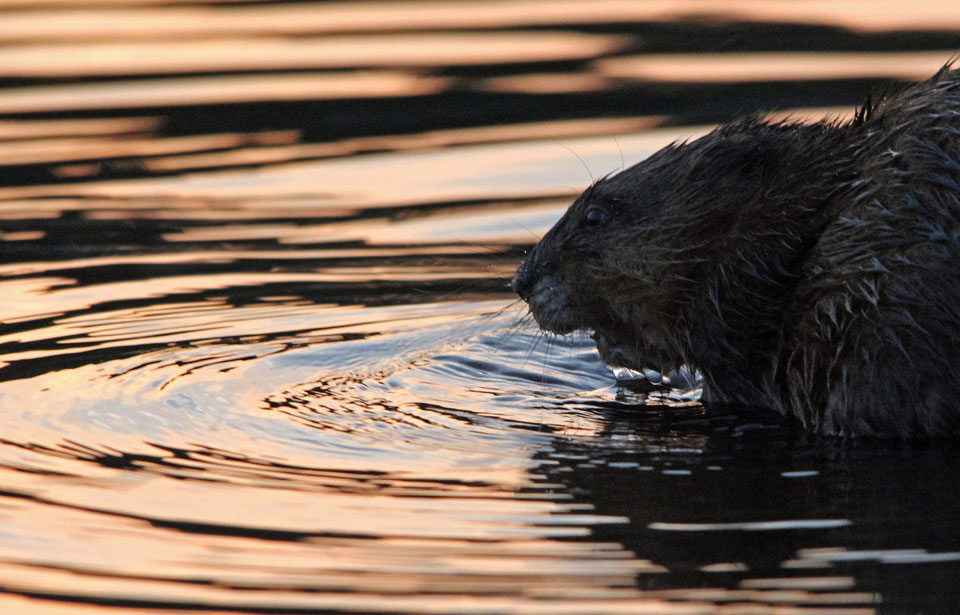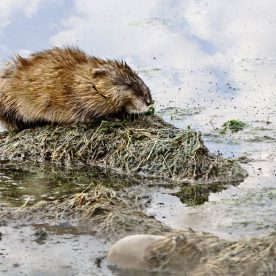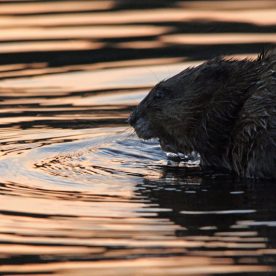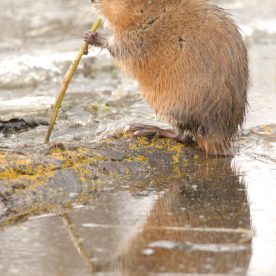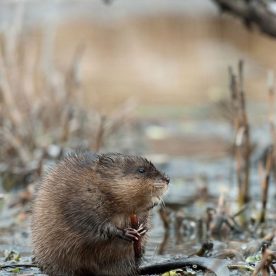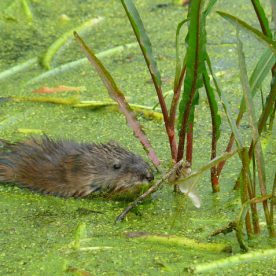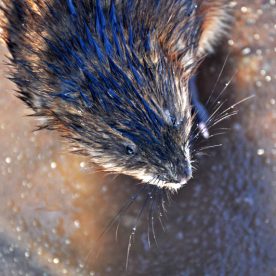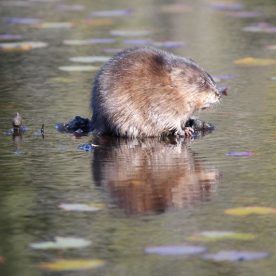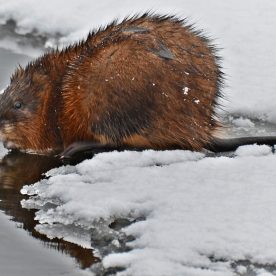Description
The muskrat Ondatra zibethicus is a fairly large rodent commonly found in the wetlands and waterways of North America. It has a rotund, paunchy appearance. The entire body, with the exception of the tail and feet, is covered with a rich, waterproof layer of fur. The short underfur is dense and silky, while the longer guard hairs are coarser and glossy. The colour ranges from dark brown on the head and back to a light greyish-brown on the belly. A full-grown animal weighs on the average about 1 kg but this varies considerably in various parts of North America. The length of the body from the tip of the nose to the end of the tail is usually about 50 cm. The tail is slender, flattened vertically and up to about 25 cm long. It is covered with a scaly skin that protects it from physical damage.
Only a minimal amount of hair grows on the feet. The hand-like front feet are used in building lodges, holding food, and digging burrows and channels. Although the larger hind feet are used in swimming, they are not webbed like those of the beaver and otter. Instead, the four long toes of each foot have a fringe of specialized hairs along each side, giving the foot a paddle-like effect. The rather small ears are usually completely hidden by the long fur. The four chisel-like front teeth (two upper and two lower incisors), each up to 2 cm long, are used in cutting stems and roots of plants.
The muskrat’s name is derived from the fact that the animal has two special musk glands—also called anal glands—situated beneath the skin in the region of the anus. These glands enlarge during the breeding season and produce a yellowish, musky-smelling substance that is deposited at stations along travel routes used by muskrats. Common sites of deposition are “toilets,” bases of lodges, and conspicuous points of land. The biology of musk glands has not been studied extensively, but the odour produced is believed to be a means of communication among muskrats, particularly during the breeding season.
Signs and sounds
In the spring, during the mating season, sharp whining noises and occasional sounds of fighting may be heard.
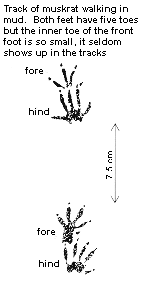
Habitat and Habits
Muskrats typically live in freshwater marshes, marshy areas of lakes, and slow-moving streams. The water must be deep enough so that it will not freeze to the bottom during the winter, but shallow enough to permit growth of aquatic vegetation—ideally between 1 and 2 m. Areas with good growths of bulrushes, cattails, pondweeds, or sedges are preferred.
Compact mounds of partially dried and decayed plant material can frequently be seen scattered among the cattails and bulrushes. These dead-looking heaps are homes of the muskrat. Bulrushes and cattails are most important, particularly in lakes. As well as being eaten, they are used as building material in the construction of lodges and feeding stations, and as shelter from winds and wave action. In northern regions, horsetails can be important in muskrat habitat.
If bulrushes or cattails are not available, muskrats dig burrows in firm banks of mossy soil or clay. Because muskrats require easy access to deep water, water depths must increase fairly rapidly from the shore where burrows are situated. This provides muskrats with an opportunity to escape from predators, and with a food supply under the ice during the winter.
Some people refer to muskrats as “house rats” and “bank rats” because the animals build lodges in certain areas and bank burrows in others. Often, these names are used in a way that suggests that these two “types” of muskrats possess inherited biological differences. This is not the case. The type of habitation used is simply a response to local conditions.
With the shortening of days and the coming of colder weather in September, preparations for winter begin. The fall is spent building and reinforcing lodges for winter occupancy, and, in some regions, storing food for winter use. Lodge building behaviour is an extremely important aspect of the ecology of muskrats. The lodge permits them to live in areas surrounded by water, far away from dry land. It protects them from enemies and gives them shelter from the weather.
A muskrat builds a lodge by first heaping plant material and mud to form a mound. A burrow is then dug into the mound from below the water level, and a chamber is fashioned at the core of the mound. Later, the walls of the lodge are reinforced from the outside with more plants and mud. A simple lodge of this type is about 0.5 to 1 m high and 0.5 to 1 m in diameter. It contains only one chamber and has one or two plunge holes, or exit burrows. More complex lodges, containing several separate chambers and plunge holes, may be up to 1.5 m high and 1.8 m in diameter.
Shortly after freeze-up, muskrats chew holes through the ice in bays and channels up to 90 m away from the lodge to create “push-ups.” After an opening has been created, plant material and mud are used to make a roof over it, resulting in a miniature lodge. Typically there is just enough room for one muskrat in the push-up. It is used as a resting place during underwater forays, and as a feeding station.
The winter is a period of relative inactivity. The muskrat is safe from the cold and from most predators. It spends most of its time sleeping and feeding until breeding activities begin after spring break-up.
The muskrat is well adapted to a semi-aquatic life style. Although fully functional on land, it has evolved characteristics that make it at home in the water. At three weeks of age it is a capable swimmer and diver. As an adult, it swims effortlessly and can do so for long periods of time. This ability is greatly facilitated by the buoyant qualities of the thick waterproof fur. When swimming on the surface, the muskrat tucks its front feet slightly forward against the upper chest while using the back feet in alternate strokes to propel the body. The tail is used at most as a rudder. When the muskrat is swimming under water, however, the sculling action of the tail probably provides as much propulsive force as do the hind feet.
In the late evening during ice-free periods of the year, muskrats can be seen swimming, sitting at feeding stations such as logs or points of land, and busily improving lodges.
Although the muskrat builds lodges near the water and is an accomplished swimmer, it is not a close relative of the beaver, as is sometimes thought. Nor is it a true rat. Instead, it is basically a large field mouse that has adapted to life in and around water.
Unique characteristics
The muskrat, together with the beaver and several other mammals, is capable of remaining submerged up to 15 minutes if in a relaxed state. Non-aquatic mammals cannot do this because they need a constant supply of oxygen and must continually expel carbon dioxide. The muskrat is able to partially overcome this problem by reducing its heart rate and relaxing its muscles when submerged; this reduces the rate at which oxygen is used. Also, it stores a supply of oxygen in its muscles for use during a dive and is less sensitive to high carbon dioxide levels in the blood than are non-diving mammals. This ability for extended dives is important in escaping enemies, digging channels and burrows, cutting submerged stems and roots, and travelling long distances under the ice.
The muskrat’s front teeth are especially modified for underwater chewing. Non-aquatic mammals such as dogs or humans would have great difficulty in trying to chew on a large object under water, because water would enter the mouth, throat, and nasal passages. This problem has been overcome in the muskrat through the evolution of incisors, or cutting teeth, that protrude ahead of the cheeks and of lips that can close behind the teeth. This adaptation permits the muskrat (and the beaver) to chew on stems and roots under water “with its mouth closed.”
Range
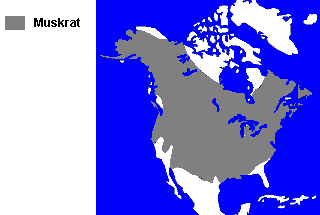 The muskrat is more widely distributed in North America than almost any other mammal and in this respect is a very successful species. It is found from the Arctic Ocean in the north to the Gulf of Mexico in the south and from the Pacific Ocean in the west to the Atlantic Ocean in the east. This broad distribution is closely related to the muskrat’s use of aquatic environments, which are common in North America. Human activities in North America during the last two centuries have not significantly affected the distribution of muskrats. In some cases, however, the draining of marshes or swamps for agricultural or other purposes has completely exterminated local populations. In others, the building of irrigation ditches and canals has increased populations.
The muskrat is more widely distributed in North America than almost any other mammal and in this respect is a very successful species. It is found from the Arctic Ocean in the north to the Gulf of Mexico in the south and from the Pacific Ocean in the west to the Atlantic Ocean in the east. This broad distribution is closely related to the muskrat’s use of aquatic environments, which are common in North America. Human activities in North America during the last two centuries have not significantly affected the distribution of muskrats. In some cases, however, the draining of marshes or swamps for agricultural or other purposes has completely exterminated local populations. In others, the building of irrigation ditches and canals has increased populations.
Until the early part of this century, muskrats occurred only in North America. In about 1905, they were introduced to Europe, where they quickly established themselves as permanent residents. They spread northward and eastward, and today are common in Europe and northern Asia.
Feeding
Of all plants available in marshes, cattails are most preferred as a food item. However, muskrats appear to thrive equally well on a diet of bulrushes, horsetails, or pondweeds, the last two constituting the basis of the diet in northern latitudes. They also eat a variety of other plants, including sedges, wild rice, and willows.
During the winter a thick layer of ice restricts the muskrat to the interior of the lodge or burrow and the watery environment beneath the ice. The animal’s highly developed diving abilities and its use of push-ups become critical in procuring food under those conditions. It covers considerable distances under the ice searching for food. When the muskrat reaches a feeding area it chews off portions of plants and carries them to the nearest push-up, where it eats. This foraging activity under perhaps a metre of ice and snow, in ice-cold water and almost total darkness, is truly a remarkable feat.
When their normal food items are scarce or unavailable, and food of animal origin is abundant, muskrats are known to be highly carnivorous, or meat-eating. Under these circumstances muskrats most commonly consume animals such as fish, frogs, and clams. However, muskrats rarely do well on this type of diet and consuming such foods is generally taken to be evidence of hard times.
Breeding
Mating activity occurs immediately following spring break-up in March, April, or May. Mating pairs do not form lasting family ties; instead, the muskrat appears to be promiscuous, or have many mates. Males compete fiercely for females. The birth of the litter, containing five to 10 young, occurs less than a month after the female has been mated. The same female normally has another litter a month after the first, and sometimes yet another a month after the second.
The young at birth are blind, hairless, and almost completely helpless, but they develop rapidly. They are covered with thin fur at the end of the first week, their eyes open at the end of the second week, and they normally begin leaving the lodge on short trips at about two to three weeks of age. Weaning, or making the transition from the mother’s milk to other foods, occurs at about three weeks, and juveniles are essentially independent of their parents at six weeks.
Breeding continues throughout the summer, with the last litters born about August. Food is plentiful during the summer and the young grow rapidly.
Few rodents live to old age; they are usually killed by other animals while still quite young, or they die accidentally. The limited information available suggests that muskrats become old at three or four years of age. When they reach this age, they lose much of their natural alertness and fall easy prey to mink, foxes, and other predators.
Conservation
The muskrat is a vicious fighter when provoked. It stands its ground courageously if an escape route to deep water is not available and can inflict considerable damage on an attacker with its long incisors, or cutting teeth. In spite of this, it is often preyed upon by other species. The mink occupies much of the same habitat as muskrats and can be the cause of heavy mortality among juveniles under certain conditions. Mink use the same burrow systems, dig into muskrat lodges, and may enter lodges through plunge holes. The snapping turtle and the northern pike also inhabit marshes and prey on the muskrat. When muskrats wander on dry land in search of new habitat, they are subject to predation by members of the dog family—wolves, coyotes, foxes, and domestic dogs—as well as by typical predators such as badgers, wolverines, fishers, racoons, and lynx.
The muskrat has long been hunted by humans, probably the major enemy or predator of this species. Prior to the colonization of North America by Europeans, it was hunted occasionally for food. With the coming of the early settlers and the introduction of guns and traps, the muskrat was hunted intensively for its fur. This activity has persisted to the present day—muskrat fur is still in demand. Also, the muskrat is still used as food by people in some parts of North America.
Muskrats, like many other wildlife species, show large fluctuations in numbers that follow what appears to be a regular pattern. In the case of the muskrat, numbers decrease drastically about every seven to 10 years. At such times, few or no muskrats can be found where two or three years earlier there had been thousands. These catastrophes are often blamed on predators or on over-trapping. However, scientists do not believe that these are the real causes. Instead, for some as-yet-unknown reason, the health of individuals deteriorates, causing widespread death and reproductive failure. Reproductive and death rates return to normal one or two years following such a population decline, leading to an increase in muskrat numbers once more.
The muskrat contributes more to the total combined income of North American trappers than any other mammal. Because of its important role in the trapping industry, it has been studied extensively. The first major studies were conducted by the Canadian Wildlife Service on the Mackenzie River Delta in the far north and the Athabasca–Peace Delta in northern Alberta during the late 1940s. A thorough understanding of habitat requirements, food habits, reproduction, longevity, causes of mortality, long-term changes in numbers, and the effect of weather on all these factors is essential to put management procedures on a sound scientific basis. The single most important contribution to our understanding of the biology and ecology of the muskrat was Paul Errington’s Muskrat Populations (1963), which combined the results of years of study by the author with information on the muskrat throughout North America. More recent studies in eastern Canada and central and eastern United States have augmented what is now a comprehensive body of knowledge on the dynamics and management of muskrat populations.
There are two major methods of managing muskrat populations: the first is to improve habitat, and the second is to regulate the commercial harvest by trappers. The most common method of improving habitat is to regulate water levels between about 1 and 2 m of depth over large areas by building dams at strategic points in lake outlets and streams. Sometimes this occurs as a natural side effect of beaver dams.
Regulation of commercial harvest is based on current population sizes and future population trends. Usually the harvest is maintained at the highest possible level that will not adversely affect population sizes and harvests in future years.
The future of the muskrat in Canada is bright. In spite of heavy trapping pressure, the draining of marshes for agricultural purposes, and unprecedented industrial activity, the species has never been endangered in Canada. Indeed, population numbers today are probably almost as high as they were a thousand years ago.
Resources
Print resources
Banfield, A.W.F. 1974. The mammals of Canada. University of Toronto Press, Toronto.
Boutin, S. 1987. Muskrat. In M. Novak, J.A. Baker, M.E. Obbard, and B. Malloch, editors. Wild furbearer management and conservation in North America. Ontario Ministry of Natural Resources, Toronto.
Errington, P.L. 1963. Muskrat populations. Iowa State University Press.
Parker, G.R., and J.W. Maxwell. 1980. Characteristics of a population of muskrats (Ondatra zibethicus) in New Brunswick. Canadian Field-Naturalist 94: 1–8.
Perry, H.R., Jr. 1982. Muskrats (Ondatra zibethicus and Neofiber alleni). In J.A. Chapman, and G.A. Feldhamer, editors. Wild mammals of North America. Johns Hopkins University Press, Baltimore.
Proulx, G., and F.F. Gilbert. 1983. The ecology of the muskrat (Ondatra zibethicus) at Luther Marsh, Ontario. Canadian Field-Naturalist 97: 377–390.
© Her Majesty the Queen in Right of Canada, represented by the Minister of the Environment, 1974, 1987. All rights reserved.
Catalogue number CW69-4/52
Text: M. Aleksiuk
Revision: G. Parker, 1986
Photo: Corel Photo Studio



